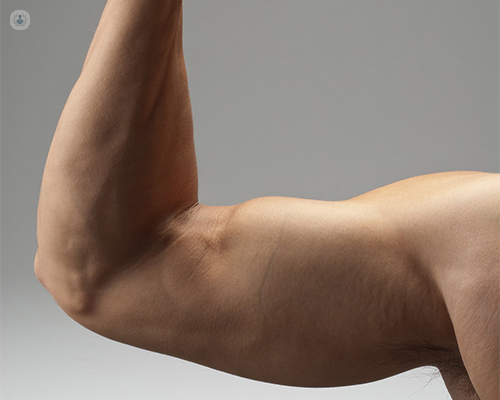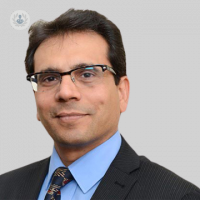Distal biceps tendon rupture repair surgery: what to expect
Written by:Once you’ve been diagnosed with distal biceps tendon rupture, you may decide to have surgery to repair it. Mr Hemang Mehta, a top consultant orthopaedic shoulder and upper limb surgeon, tells you everything you need to know about this operation.

What are the benefits of surgery?
The overall goal of the surgery is to improve strength and return the patient to full function. This is done by reconnecting the distal biceps tendon to the bone, which then enables the muscle to regain power
What happens during distal biceps tendon repair surgery?
Surgery is typically performed under general anaesthetic with a tight strap known as a tourniquet, which may be used to reduce bleeding. An incision about three to five centimetres long is made over the front of the elbow. First, the ruptured part of the tendon is located. Next, sutures are put into the tendon so that it can be pulled back down to the bone. Implants known as anchors are then put into the radius bone for reattachment of the tendon. The sutures that were attached to the tendon earlier are fixed to the bone via the anchor site. This fixes the tendon back to the bone. The incision is closed with sutures and a dressing is applied. A half plaster cast or brace may also be fitted.
What are complications that can happen?
Some potential complications that can happen during surgery are:
- Heart attack, stroke, and blood clot formation can very occasionally be caused by anaesthesia and surgery.
- Infection; this can be treated with antibiotics alone, but more surgery may be needed. Chances of this complication are about one per cent.
- It’s unlikely, but bleeding into the elbow joint may happen. Additional surgery may be needed to clean out the joint.
- Nerve injury around the elbow can lead to weakness in the muscles that lift the wrist and straighten fingers. Usually, this recovers on its own after several months, but physiotherapy or surgery may be needed.
- If the rupture is more than three weeks old, it may not be possible to undertake a repair, as the tendon will retract up the arm, and scar tissue may prevent the surgeon from being able to reattach it to the correct site.
- Complex Regional Pain Syndrome (CRPS): this is a rare complication with an unknown cause. The patient experiences pain, stiffness, and loss of use of the hand and arm. Full recovery may take many months, or even years. Further treatment involving physiotherapy and medication is required.
- Reoccurrence: if the muscle does not heal correctly, or at all, to the bone. This repair fail happens to a proportion of procedures.
What is the recovery like after surgery?
The surgery can normally be done as a day case, but an overnight stay may be needed if the operation is late in the day, or if monitoring of other medical conditions is needed after the operation.
Waking up after surgery, the arm will be in a sling with dressing over the wound. There is usually a brace or half- plaster back slab. There will little pain in the first few hours due to local anaesthesia injection. A physiotherapist will typically make a visit to advise on exercises before discharge. Regularly moving the fingers and thumb is important to prevent stiffness and reduce swelling. Occasionally, stiffness in the elbow can occur. If so, continuing to work with the physiotherapist is important to try and avoid this.
Ten to fourteen days after the procedure, the stitches will need to be removed, unless dissolvable, and a check on the wound. Keeping the wounds dry decreases the chance of infection. It is common to see the surgical team at about six weeks after surgery.
Outpatient post-operative rehabilitation will happen with the physiotherapy team. It is important to protect the repair while it is healing, but do regular controlled movement to minimise elbow stiffness during the first six weeks. Once the elbow can be straightened comfortably, the sling is not needed. Six weeks after the operation, forceful bending of the elbow, like lifting weights, and forced straightening of the elbow, may be permitted.
Usually six weeks after the surgery, driving may be resumed once there is sufficient pain-free active movement, strength, and control, allowing competent full control of the vehicle.
Returning to work depends on the nature of the job. Desk work can typically return after about six weeks, though some people need longer. Manual work is likely to need a longer recovery period, to avoid damage to the repair from heavy activities. About three months off before returning to full duties may be required.
Sports depend entirely on how quickly flexibility and muscle strength take to recover and the type of sport. The physiotherapist can guide how to gradually return to this.
What if I don’t have surgery?
Without surgery, the tendon will not heal and so the biceps will not regain full power, but it is an option to leave it alone. Often, other muscles will take over and the power of bending the elbow may gradually recover, although it may not be the same as previously. The arm may also look smaller, permanently. There tends to be a permanent loss in power of the movement called supination, such as using a screwdriver. The surgeon and the patient will decide together if surgery is the best option.
If you have recently been diagnosed with a distal bicep tendon rupture or would like more information, you can schedule a consultation at Mr Mehta's profile.


